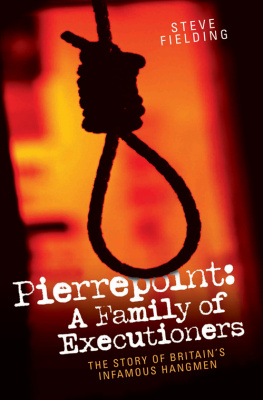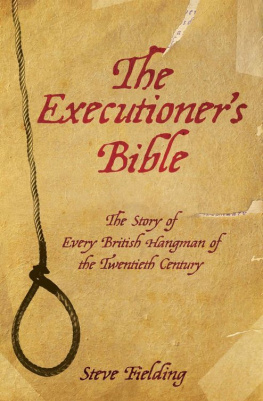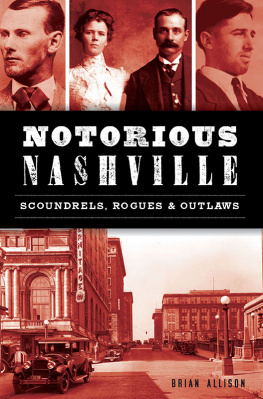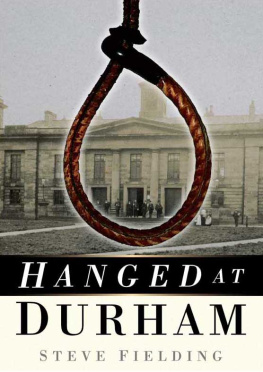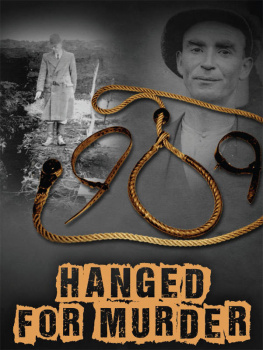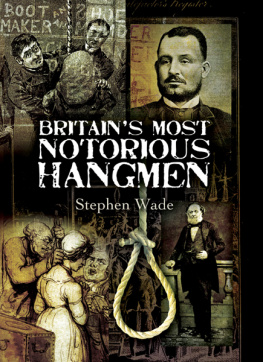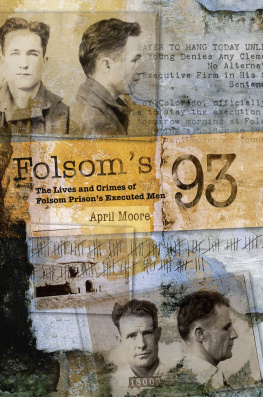CONTENTS
THE SENTENCE
OF DEATH
T he sentence of the Court upon you is, that you be taken from this place to a lawful prison and thence to a place of execution and that you be hanged by the neck until you be dead; and that your body be afterwards buried within the precincts of the prison in which you shall have been confined before your execution. And may the Lord have mercy upon your soul. Amen.
T his book mainly covers the period of 1901 to 1956, and deals with the lives and times of a unique family: a father, Henry Pierrepoint; a son, Albert, and an uncle, Thomas, who each, at one time, held the position of Hangman of England.
Henry Pierrepoint applied to become a hangman just three weeks after the death of Queen Victoria, whose reign of sixty-four years had seen numerous changes in the way law and order was applied and carried out. During her reign, a sentence of death was passed for a variety of crimes, including burglary, rape and attempted murder. Gradually sentence of death ceased for all crimes apart from wilful murder, although the sentence was still carried out in public. It is remarkable to think that in the late nineteenth century, one could travel by underground train in London to watch an execution carried out in front of the prison gates.
Public executions ended in 1868, although members of the press were still present to report in macabre detail what they had witnessed.
All the people executed during the period covered by this book were convicted of murder, except during the period when Thomas Pierrepoint officiated; during the First World War one person was convicted of treason and hanged, and fifteen men were hanged as a result of the 1940 Treachery Act. Added to this are a number of American servicemen convicted of offences that were not deemed worthy of the death penalty in twentieth century Great Britain.
Furthermore, during Albert Pierrepoints time as Chief Executioner, over two hundred people were hanged for offences punishable by the death penalty under the rules of the War Crimes Commission. Albert also hanged the last men convicted of treason during the Second World War.
The Pierrepoints stock in trade was being skilled at conducting the final act in the penal life of a condemned man the physical process of hanging him by his neck. The process changed little over the three generations involved, and the cold, unemotional tones of the 1953 Royal Commission Report description would have rung true to all three Pierrepoints.
Immediately a prisoner sentenced to death returns from court, he is placed in a cell for condemned prisoners and is watched day and night by two officers. Amenities such as cards, chess and dominoes are provided in the cell and the officers are encouraged to join the prisoner in these games. Newspapers and books are also provided. Food is supplied from the main prison kitchen, the prisoner being placed on hospital diet.
In most of the English prisons equipped for execution the execution chamber adjoins the condemned cell. The chamber itself is a small room and the trap occupies a large part of the floor. The trap is formed of two hinged leaves held in position from below by bolts, which are withdrawn when the lever is pulled, allowing the leaves to drop on their hinges. Above the trap a rope of a standard length is attached to a strong chain, which is fitted to the overhead beam in such a way that it can be raised and lowered and secured at any desired height by means of a cotter slipped into one of the links and a bracket fixed on the beam. This enables the length of chain to be adjusted to make the drop accord with the height and weight of the prisoner.
The executioner and his assistant arrive at the prison on the afternoon before the execution. They are told the height and weight of the prisoner and are given an opportunity to see him from a position where they themselves cannot be seen. While the prisoner is out of the cell they test the apparatus to ensure that is working satisfactorily. For this purpose they use a sack of approximately the same weight as the prisoner, having ascertained the proper drop from a table which gives the length appropriate to a prisoners weight. Some adjustments in the length given in the table may be necessary to allow for other physical characteristics of the prisoner, such as age and build.
On the morning of the execution a final check of the equipment is carried out. The rope is coiled, fitted to the chain, and secured in position by a piece of pack thread which will be broken by the weight of the prisoner when he drops. Just before the time of the execution the executioner and his assistant join the Under Sheriff and the prison officials outside the door of the condemned cell. The Under Sheriff gives the signal: the executioner enters the cell and pinions the prisoners arms behind his back, and two officers lead him to the scaffold and place him directly across the division of the trap on a spot previously marked with chalk. The assistant executioner pinions the legs, while the executioner puts a white cap over his head and fits the noose round his neck with the knot drawn tight on the left lower jaw, where it is held in position by a sliding ring. The executioner then pulls the lever. The medical officer carries out an immediate inspection to assure that life is extinct and the body is then left to hang for an hour before being taken down.
CHAPTER 1:
February 11th 1901
Dear Sir,
I wish to inform you that I should be very thankfull if you would accept me as one of the public executioners should at any time Mr Billingtons term expires as I have always had a desire for that appointment. I am 24 years of age, height 5ft 8 inches. Should you require particulars of my character I shall be very glad to give you all the information you require. Hoping the application will be off no offence.
I am yours
Respectfully
Henry Albert Pierrepoint
No 53 Fielden St.
Off Oldham Road
Manchester
I t was this short note, sent to Home Secretary Sir Matthew Ridley in the early part of 1901, which set in motion a chain of events that resulted in the Pierrepoint family name becoming one of the most famous in modern British criminology, and being connected with capital punishment for the next half century.
Henry Harry Albert Pierrepoint was born in 1878 at Sutton Bonington, Nottinghamshire. He was the fourth child, and second son, to Thomas and Ann Pierrepoint, who ran the Kings Head on 14 Main Street, at East Leake. Soon after Harrys birth, Thomas found work looking after the horses at a Yorkshire quarry and the family uprooted from Nottinghamshire. The 1891 census shows they lived on Wolsley Street, Clayton, near Bradford; Thomas Pierrepoint and his eldest son, also named Thomas, were listed as being employed as quarrymen.
Harry was working at a worsted mill in Clayton, aged 13, when he read about the exploits of the well-known Bradford hangman James Berry, whose career as the countrys chief executioner had come to an end following a series of botched executions and run-ins with prison authorities. After reading about James Billingtons appointment to succeed Berry, Harry quickly decided it was what he wanted to do too an ambition that stayed with him night and day, never leaving him. Other boys dreamt of becoming soldiers or engine drivers; Harrys dream was to become an executioner. Over the next few years he hungrily lapped up newspaper accounts of Billingtons thrilling adventures across the country as he dashed by railway from one prison to another carrying out his official duties, executing the criminals whose exploits had been splashed across the weekly scandal sheets names such as the notorious Dr Cream (the Lambeth poisoner) and baby farmer Amelia Dyer.

